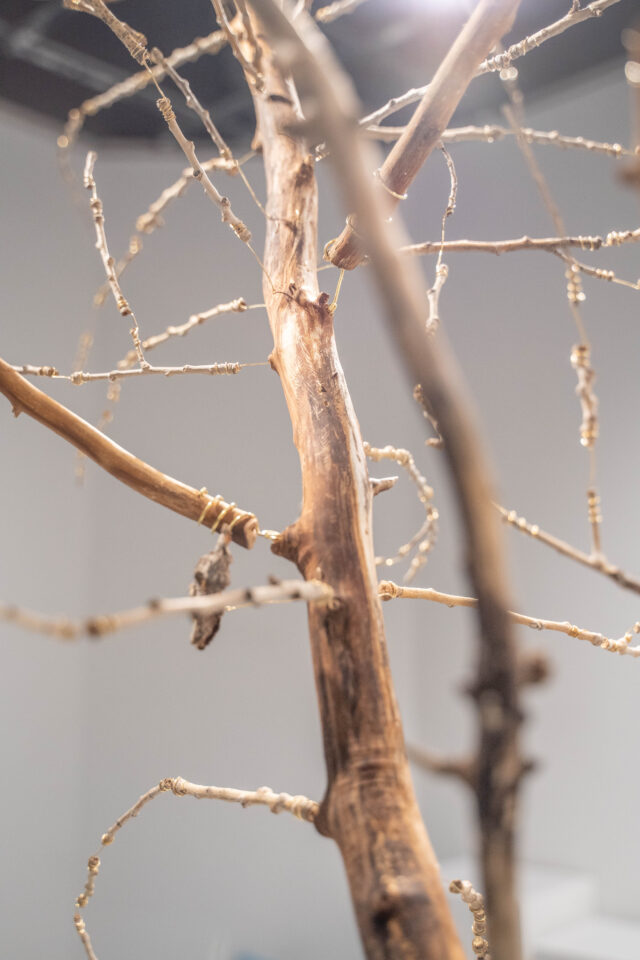Kayli Cottonwood is the sole creator of the 7-foot-tall, 4-foot-wide sculpture on display at the Center for Visual Art. The display makes the piece even larger, reaching 9 feet in height. Their creation culminated in two years spent actively obtaining cottonwood branches and nine months of assembly time. “What Have We Lost” has no solid connections, plastics, or artificials. Only three materials are used: cottonwood, brass, and steel, all to highlight the beauty of nature on its own.
From a distance, it seems sparse, with some parts almost floating and unconnected. These aspects of the sculpture call for closer inspection, like the flashes of thin wire, brass, and steel or the tiny sticks seemingly suspended in the air. Everything is held together with a tension wire.

“Treating the tree as a corpse and me as a mortician, putting the skeleton back together, putting the hand’s joints back together, and making them ready for viewing,” Cottonwood said on the delicate creation of the tree.
After finding the main branch years ago, they worked to collect the rest of the materials and began the painstaking process of deconstructing each item.
“The deconstruction was really important because as we are thinking on a larger scale processing, like how we use wood, there’s so much waste,” Cottonwood said.
Each time the tree is moved, it’s deconstructed and reassembled—a process that can take up to seven hours. Every branch, stick, and twig is suspended on thin wires of bronze or steel. Even the bark on the trunk is attached by a meticulously placed wire.
Cottonwood’s connection with the tree of their namesake blooms from their childhood. Growing up in an area surrounded by cottonwoods, they have collected the branches ever since.
When peering closer to the branches, details can be seen inside some stems, such as a star stamped in the middle of the wood. When they were young, Cottonwood’s mother taught them about this naturally occurring phenomenon.
“We’d go walk through the cottonwoods and pick up the sticks, and she told me if you break it and get a star, you make a wish. And then you can have your wish come true,” said Cottonwood.
Other projects Cottonwood has in the works include one that involves the yarn they’ve collected over the years, highlighting that it’s made almost entirely out of plastic- not natural materials like wool or cotton. Another work concerns ceramics and how the right materials to make clay can be sourced ethically and responsibly, but often, they’re not.
Cottonwood’s connection with art began when they were very little. Thanks to their mother and sister, they grew up surrounded by art. Recently, they have begun to deepen their connection to nature and their mother,
“Art definitely runs in the family. But I think what it really comes down to is just being taught and encouraged to think creatively.”
Much of their inspiration and passion for nature bloomed from further research. Anthropocene is a term that describes the current geological age. It is viewed as the period during which human activity has been the dominant influence on climate and the environment. Cottonwood’s art emphasizes how we have harmed our world.
“It’s essential, and I think my work is really talking about that and responding to that grief and anger, all the negative emotions that come up with that.”
All of the materials used in the piece have been closely researched. History supports the intention behind every part, telling a deeper story with each piece.
“What We Have Lost, the title kind of speaks to several layers of that right, not only the species that we’ve lost from climate change, the Anthropocene, but also what did we lose in my creation of this?” Cottonwood asked.
Cottonwoods are drought-resistant trees but die after a prolonged lack of water. They grow alongside rivers and creeks, benefiting from floods and spring melts. As an adaptive coping technique, the trees drop leaves during drought and extreme heat. Cottonwood has given us the look of a drought-suffering tree, the broken pieces reassembled to remind us of what once was.
During their research, Cottonwood studied water rights, which they say are messy and complex. The Colorado River runs through five states, each depending on the river in some way. What we do here impacts all of them. Colorado does what it can to preserve our way of life and make room for more. As Colorado balances those challenges, it seems inevitable something will be lost along the way. The cottonwoods must brave the neglect that comes from reliance on seasonal weather changes.
“Cherry Creek Reservoir, for example, or other dams, creates a huge lack of water for the trees. So the cottonwood trees really rely on spring snowmelt to cause flooding, and we’ve put those things in place to prevent flooding, so it doesn’t affect us. So in protecting ourselves, we’ve directly harmed something else,” said Cottonwood.
Their work delves deeply into this concept. The roots of “What We Have Lost” are steel, a cold industrial metal meant to be a clear separation between the wood and the ground. Akin to a saw gnawing at roots, the steel represents our human intervention in the life of the cottonwoods.
Every tiny detail of Cottonwood’s “What Have We Lost” has some meaning below the steel wires. Cottonwood intends to guide us deeper into their passions, “There’s a lot that I want to talk about in terms of like capitalism or over culture and just the society at large and how we have a lot of disenfranchised grief because it’s not addressed in the media and it’s not talked about enough.”
Follow along on their Instagram: @cottonwoods.studio or their website: cottonwoodstudio.art to see their future projects as they continue “Finding ways to tell the story of my sibling, the tree, and still make it beautiful in its tragedy.”